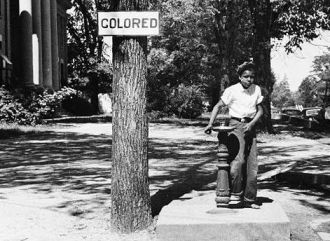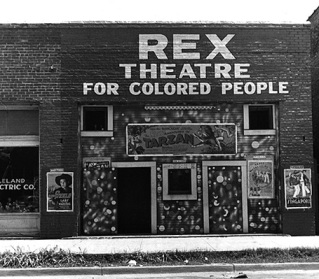RACIAL SEGREGATION
When the United States of America was founded in the 1700s, slaves from Africa were used to work the land. In 1804 most of the Northern states of America banned slavery and wished the Southern states to do the same. However, the Southern states believed that slavery was right and part of their life; it was something they did not want to give up. The Southern states tried to leave America and the American Civil War began. President Abraham Lincoln led the North to victory over the South and in 1865 slavery was banned throughout the whole country.
There was still much racism and African Americans were not treated fairly. There were many laws that kept them working in hard jobs for little money, and laws that prevented them from marrying European Americans. Slavery had ended, but segregation had not. Black Americans in the south, and in some places in the north, were not allowed to attend the same schools as white Americans, but had to attend black-only schools. Buses and shops had separate sections, and some simply didn't allow black people. Restaurants and hotels were usually completely separate. There were black and white parts of towns and cities, in most of the country.
It was not until the 1950s and 1960s that things began to change. A man named Martin Luther King, Jr. began to rally for equal rights for blacks. He led many African Americans on marches to protest the way they were treated. He was killed in 1968, but four years earlier he convinced the government to allow black Americans to vote in the presidential elections. In the law case Brown v. Board of Education, the government went on to force integration in high schools throughout the United States, making it illegal to have white-only schools. For a while, armed police officers had to escort black students into formerly white-only schools, and it took many years for the schooling system to change. It took many more decades to get rid of all the racist laws.
African Americans now have all the same rights as European Americans and other Americans, but there is still some racism in the United States of America as there is in every country.

The Ku Klux Klan was originally organized in the winter of 1865-66 in Pulaski, Tennessee as a social club by six Confederate veterans. In the beginning, the Klan was a secret fraternity club rather than a terrorist organization. (Ku Klux was derived from the Greek "kuklos," meaning circle, and the English word clan.) The costume adopted by its members (disguises were quite common) was a mask and white robe and high conical pointed hat.
The Klan spread beyond Tennessee to every state in the South and included mayors, judges, and sheriffs as well as common criminals. The Klan systematically murdered black politicians and political leaders. It beat, whipped, and murdered thousands, and intimidated tens of thousands of others from voting. Blacks often tried to fight back, but they were outnumbered and out gunned. While the main targets of Klan wrath were the political and social leaders of the black community, blacks could be murdered for almost any reason. Men, women, children, aged and crippled, were victims. A 103-year-old woman was whipped, as was a completely paralyzed man. In Georgia, Abraham Colby, an organizer and leader in the black community, was whipped for hours in front of his wife and children. His little daughter begged the Klansman, "Don't take my daddy away." She never recovered from the sight and died soon after. In Mississippi, Jack Dupree's throat was cut and he was disemboweled in front of his wife, who had just given birth to twins. Klansman burned churches and schools, lynching teachers and educated blacks. Black landowners were driven off their property and murdered if they refused to leave. Blacks were whipped for refusing to work for whites, for having intimate relations with whites, for arguing with whites, for having jobs whites wanted, for reading a newspaper or having a book in their homes.. Or simply for being black. Klan violence led one black man to write: "We have very dark days here. The colored people are in despair. The rebels boast that the Negroes shall not have as much liberty now as they had under slavery. If things go on thus, our doom is sealed. God knows it is worse than slavery."
A few state governments fought back. In Tennessee and Arkansas, Republicans organized a police force that arrested Klansmen and carried out executions. In Texas, Governor Edmund Davis organized a crack state police unit, 40 percent of whose officers were black. The police made over 6,000 arrests and stopped the Klan. Armed groups of black and whites fought or threatened Klansman in North and South Carolina. The federal government also exerted its influence, empowering federal authorities with the Enforcement Acts of 1870 and 1871. Klan activity ended by 1872 and disappeared until it was revived again in 1915.
| |||||||||
What were the Jim Crow laws?
Jim Crow laws were laws in the South based on race. They enforced segregation between white people and black people in public places such as schools, transportation, restrooms, and restaurants. They also made it difficult for black people to vote.
When were the Jim Crow laws enforced?
After the Civil War there was a period in the South called the Reconstruction. During this time the federal government controlled the southern states. However, after the Reconstruction, the state governments took back over. Most Jim Crow laws were put in place in the late 1800s and early 1900s. Many of them were enforced until the Civil Rights Act of 1964.

Why were they called "Jim Crow"?
The name "Jim Crow" comes from an African-American character in a song from 1832. After the song came out, the term "Jim Crow" was often used to refer to African-Americans and soon the segregation laws became known as "Jim Crow" laws.
Examples of Jim Crow Laws
Jim Crow laws were designed to keep black and white people apart. They touched on many aspects of society. Here are a few examples of laws in different states:
- Alabama - All passenger stations shall have separate waiting rooms and separate ticket windows for the white and colored races.
- Florida - The schools for white children and the schools for black children shall be conducted separately.
- Georgia - The officer in charge shall not bury any colored persons upon the ground set apart for the burial of white persons.
- Mississippi - Prison wardens shall see that the white convicts shall have separate apartments for both eating and sleeping from the negro convicts.
Grandfather Clauses
In order to make sure that all white people could vote, many states enacted "grandfather" clauses into their voting laws. These laws stated that if your ancestors could vote before the Civil War, then you did not have to pass the reading test. This allowed for white people who could not read to vote. This is where the term "grandfather clause" comes from.

Black Codes
After the Civil War, many southern states created laws called Black Codes. These laws were even harsher than the Jim Crow laws. They tried to maintain something like slavery in the south even after the war. These laws made it difficult for black people to leave their current jobs and allowed them be arrested for just about any reason. The Civil Rights Act of 1866 and the Fourteenth Amendment tried to put an end to the Black Codes.
Fighting Segregation
African-Americans began to organize, protest, and fight segregation and the Jim Crow laws in the 1900s. In 1954, the Supreme Court said that segregation of the schools was illegal in the famous Brown v. Board of Education case. Later, protests such as the Montgomery Bus Boycott, the Birmingham Campaign, and the March on Washington brought the issue of Jim Crow to national attention.
The End of Jim Crow Laws
Jim Crow laws were made illegal with the passage of the Civil Rights Act of 1964 and the Voting Rights Act of 1965.
Interesting Facts about Jim Crow Laws
- The U.S. army was segregated until 1948 when President Harry Truman ordered the armed services desegregated.
- As many as 6 million African-Americans relocated to the North and West to get away from the Jim Crow laws of the south. This is sometimes called the Great Migration.
- Not all Jim Crow laws were in the south or were specific to black people. There were other racial laws in other states such as a law in California that made it illegal for people of Chinese ancestry to vote. Another California law made it illegal to sell alcohol to Indians.
- The phrase "separate but equal" was often used to justify segregation.
American civil rights movement
![March on Washington [Credit: UPI/Bettmann/Corbis]](http://media-3.web.britannica.com/eb-media/46/7546-003-3C1CBD7A.jpg)
A mass protest movement against racial segregationand discrimination in the southern United States that came to national prominence during the mid-1950s. This movement had its roots in the centuries-long efforts of African slaves and their descendants to resist racial oppression and abolish the institution of slavery. Although American slaves were emancipated as a result of the Civil War and were then granted basic civil rights through the passage of the Fourteenth and Fifteenth amendments to the U.S. Constitution, struggles to secure federal protection of these rights continued during the next century. Through nonviolent protest, the civil rights movement of the 1950s and ’60s broke the pattern of public facilities’ being segregated by “race” in the South and achieved the most important breakthrough in equal-rights legislation for African Americans since the Reconstruction period (1865–77). Although the passage in 1964 and 1965 of major civil rights legislation was victorious for the movement, by then militant black activists had begun to see their struggle as a freedom or liberation movement not just seeking civil rights reforms but instead confronting the enduring economic, political, and cultural consequences of past racial oppression..
”Nigger” ??
”Nigger” (pronounced Nigre) was the old southern
word for black people – it came from the French word “Negre” - meaning black – but became pejorative
because of southern racism.
President
Truman, (1945 – 1952), who helped the black people a lot, used the term “Nigger”,
because he was from the South.
“Negro” is
the Spanish word for “black”. After the WWII, it became the household word for
black people. Martin Luther King speaks about the Negro race.
In the
1970’s, there was a big movement to fight for the rights of minorities.
According to the American System with a lack of central power, the battle was
often fought in courts. Pejorative expressions were forbidden. “Pejorative
“ means putting people down. In
came “Political Correctness” (PC). The official expression for black people
then became “Afro – Americans” (like “Indians” became Native Americans”).
That, of
course , created some baroque decisions. The celebrated and world famous novel by Mark Twain,
“Huckleberry Finn”, is about this
homeless white boy, Huckleberry, assisting a black slave to escape – and the
slave is like his big brother. To this day, this classical masterpiece with a
very human message, is banned in the USA in a lot of public libraries. Why?
Because it uses the phrase: “Nigger”.
Court rooms
only decide what is right and wrong according to the law, not what is common
sense.
Today, the
phrase “Blacks” is accepted. You can always argue, who is ”Black” or “White”.
“Whites” certainly don’t have a white skin, more a tan with a shade changing
from kind of pink/yellow to light brown. “Blacks” in the USA are more like dark
brown. Obama is a Mulatto with a father from Kenya in Africa and a very “white”
mother. Why call him “Black” and not White”?
LINKS:
http://afroamhistory.about.com/
http://www.pbs.org/wnet/aaworld/timeline.html
http://www.timeforkids.com/minisite/black-history-month
http://www.neok12.com/Civil-Rights-Movement.htm
LINKS:
http://afroamhistory.about.com/
http://www.pbs.org/wnet/aaworld/timeline.html
http://www.timeforkids.com/minisite/black-history-month
http://www.neok12.com/Civil-Rights-Movement.htm


Kommentarer
Send en kommentar